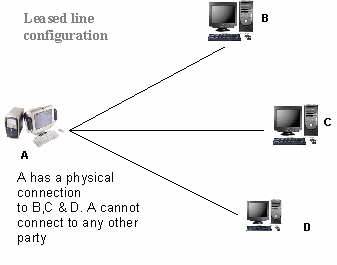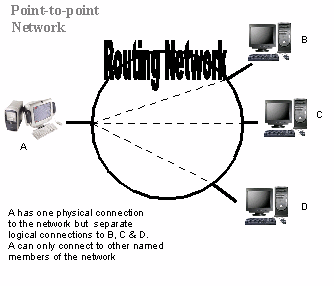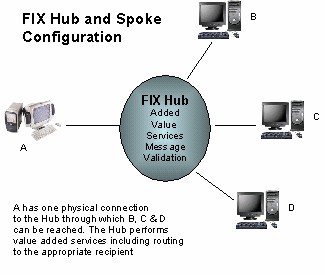Implementation GuideContents | Previous | Next | Terms of Use 3. Choosing a networkSelecting an FIX order routing networkA critical component of building an electronic trading infrastructure is choosing an appropriate network model to connect with your trading partners. In today's market, routing networks, leased lines and the Internet are all are popular options with varied features and benefits to each.This guide is strictly vendor neutral and consequently general in content. Every vendor has their own value proposition and their offerings tend to be some mix of that described here. A high level overview of the different network options together with their associated advantages and disadvantages is presented here. Additionally, a section is devoted to aspects of networks that are relevant to any selection exercise such as cost, functionality and service levels. Finally, a set of guidelines for undertaking any selection such as this is included as a conclusion. Leased LinesA leased line is simply a direct connection between you and your counterparty via a telecommunications circuit. The connection is available all day, every day at a fixed cost depending on the size of the circuit (56k, 64k, T1, etc.).
AdvantagesLeased lines are appealing because they are a private physical connection between trading partners.DisadvantagesIf your firm maintains connections with many trading partners, a dedicated circuit to each can become costly and complex in terms of managing a data center. Additionally, leased lines often take a number of weeks and usually months to have installed.The InternetThe Internet is a worldwide public network of computers, sustained by a multitude of users all with different business practices in mind. The Internet can provide either a very low-speed connection at little cost or a much higher-speed connection at a greater cost.AdvantagesThe Internet is a scalable connectivity solution, and has a significant cost saving derived from its multiple uses. Unlike leased lines, connecting to your trading partners via the Internet does not require dedicated hardware to be ordered for each installation, and is therefore much quicker to get set up. With the largest number of participants of any network, you can generally connect to most anyone you want and the set-up cost is trivial.DisadvantagesThe Internet offers no real form of control. For instance, heavy trading days a few years ago all but collapsed the Internet for a brief time, and the Internet regularly slows down when the US trading day begins. Although relatively cheap to deploy, the opportunity cost of your Internet connection failing can be high.The Internet is also insecure. It is possible to employ software encryption such as PGP-DES-MD5 or SSL to overcome this, but some firms still believe it is easier to intercept Internet traffic than data sent over a secure private network. For this reason some firms have a policy of not using the Internet for sensitive business traffic. Thus a connectivity solution using the Internet may present problems connecting to all necessary trading partners. Point-to-Point VPNIn a point-to-point VPN (Virtual Private Network) you have one physical connection into the network but separate logical connections to each of your counterparties.
Typically point-to-point VPN's take whatever data you send and pass it untouched to the recipient. The network effectively functions as a postal service. Some VPN's are private, meaning only data from permissioned users of the VPN operate on the network. Others are public, and your data traverses a shared infrastructure contending for space with a variety of other network types such as voice and video. Encryption is generally implemented at the router level. Outgoing traffic is encrypted by the router at one end of a connection and decrypted by the router at the other end. This implies a requirement for all parties to have more powerful routers, increasing usage costs and affecting the overall speed of delivery. AdvantagesThe main advantage of point-to-point VPN's is a reduction in complexity and cost of managing many connections. Regardless of the number of connections to trading partners, you only have to manage a single physical line into the network. Adding a new connection is straightforward and only a logical activity. Unless there is a problem with the network as a whole, when one connection fails all your remaining connections are unaffected. Acting as a postal service, point-to-point VPN's are generally very fast.DisadvantagesAny trading network is only as good as the trading partners connected to it. If the trading partners you do business with are not connected to the network you choose, that is obviously a big disadvantage. Also, VPN's that operate over public networks present the risk that your traffic will lose out in priority to other types of traffic. Additionally, if there is a problem with the network or you lose your physical connection into it, you will lose access to all of your trading partners.Hub-and-SpokeIn the hub and spoke network model, you make one physical and logical connection to the network. All communication between you and your trading partners is passed through a hub where you will generally find a FIX engine.
Your FIX engine sends a FIX message into the hub with information that tells the hub who the recipient should be. The hub receives and parses the message before routing it on to the appropriate destination. Through this single logical connection you are able to communicate with any other participant on the network with no need to have new logical connections created, install hardware, or undertake the task of FIX certifying your OMS application with your counterparty's. The infrastructure of a hub and spoke network allows messages to be operated on and even stored. Depending on the capabilities of the FIX engine in the hub, this can includes functionality such as message validation, symbol translation (e.g. ISIN to SEDOL), protocol translation (e.g. SWIFT to FIX) and archiving of trade information. An important aspect of a hub is that the underlying physical network can be the Internet, a network owned and run by the hub, or belong to a point-to-point network vendor. Thus a hub can be viewed as consisting of two separate layers. One provides the functionality of the hub (as described above), whilst the second layer provides the underlying network. Some interoperability is possible, though this is dependant on whether the hub is open or closed. In the scenario where a hub can be reached through more than one VPN, interoperability at the hub level can override a network's lack of interoperability. In an open hub situation, a firm connected to the hub via "VPN A" can reach a firm connected to the hub via "VPN B". However, if the hub is closed then this is not possible. The hub only allows participants on the same underlying network to exchange information. AdvantagesThe main advantage of a hub and spoke network is that it's a simple and cost effective means of connecting many trading partners. You manage a single logical connection and can reach any other firm on the network.Some hub and spoke networks have the notion of FIX certification. Here all participants of the network test their functionality against that of the hub to the point where the participant's trading application is "FIX certified" against the hub. FIX Testing and Certification is covered in chapter 10 of this guide. The advantage is that once certified, you can trade with any other certified counterparty over the network without additional testing. This saves a great deal of time and money. Other hub and spoke networks offer syntactical certification as an alternative to functional certification. Here the hub is only concerned with the FIX messages you send and that the way you send them conforms to the FIX specification. It will simply pass FIX messages from sender to receiver. This way you can use the hub to connect to others but not be restricted by the functionality of the hub's FIX implementation. In a scenario where a hub uses a point-to-point network for its physical infrastructure interoperability amongst the networks may be possible. However, this depends on permission from the hub. DisadvantagesIn some instances, the functionality available via a FIX hub and spoke network is governed by the capabilities of the FIX engine in the hub. While you and your trading partners may be able to send and receive FIX allocation messages or perform Program Trading via FIX, if the hub doesn't support that functionality it cannot be used.An obvious disadvantage is that a single point of failure exists in the network. If the hub fails then all connectivity to your trading partners is lost. Additionally, as it relates to service levels, there can be a latency effect implied by messages passing through a hub that stores or operated on them. The amount of latency varies from network to network but it is something that should be borne in mind in any selection exercise. The choice of underlying network also defines some of the performance and service levels of the hub. If the performance or service level of the underlying network is poor, the hub will suffer as a result. One size doesn't fit allAny connectivity project should include some consideration of how many counterparties are being targeted and their profile. No doubt there will be large tier brokers on the list and most of the time these will be targeted first. These firms will likely be connected to most networks and have the resources to connect to you, but what about the others? What about counterparties you don't trade with often, or those that only connect to one or two networks, or don't have much in the way of resources?It is not uncommon for firms to use at least two networks. A second network can provide access to additional trading partners, or provide redundancy for disaster recovery or backup purposes. All network types have advantages and disadvantages, and no one type is necessarily better than another. As with most aspects of an implementation, your solution will depend on your goals and objectives. Costs of FIX networksThere are a number of costs associated with implementing and using a FIX network. They often increase depending on a number of factors including but not limited to the level of redundancy you want, hardware encryption, the number of connections you have and the amount of traffic you send.Capital costsMost network vendors charge an installation fee but nothing for the router which generally remains their property. In today's market it is quite common for a vendor to give you a larger router than you initially need. This means that increases in bandwidth can be accommodated easily. If you want to employ hardware encryption, the router will need to be more powerful and operating costs rise accordingly.It is common for an ISDN line to be purchased to act as backup, and in many cases also common to have an identical router, providing for two levels of redundancy. You generally need to purchase a local tail (a very small leased line) to provide connectivity from the networks' point of presence (PoP) to your building. If your offices are in a financial or commercial center then this cost should be minimal. Costs for this will rise if the PoP is far from your building. Finally, a person or team of people is needed to manage the installation and running of the network. Costs for using the connectionThere are a variety of pricing models across the vendor community, but they are all predicated on three basic models.
Per messageThis model is as its name suggests. You pay a fee for each message sent over the network. A "message" can be classed as a FIX message, an order, or an executed order, depending on the network. Often this model is banded so that you pay a lower amount the more messages you send. This model is ideal if you generally have low trading volumes.BandwidthIn this model you pay monthly for a certain amount of bandwidth. This can be quite cheap as it is feasible to support two or three counterparties trading light volumes over a 64k connection. Some networks support dynamic bandwidth allocation. If you exceed your allotted bandwidth you will be allowed to do so, but will be charged for the next highest bandwidth denomination (i.e. 128k if exceeding 64k).The bandwidth model is ideal if you are trading with relatively high volumes, or are unsure of future growth potential. It scales easily, therefore you can manage the cost based upon your business. Percentage of trade valueAn additional pricing model is one where network providers register as a broker/dealer. Here the network provider charges the broker a certain number of basis points of the value of the trade with a cap and a collar. For example, �2.50 minimum up to a maximum of �25 per trade. This model has not yet gained traction in Europe.Opportunity CostsOpportunity costs arising from a network being unavailable are something that must be also considered. How significant an impact on your business would an outage be? Would you be able to notify your counterparties quickly enough? Would you have the capacity to take all would-be electronic orders via the phone? Would you lose money? How much?Working on what the opportunity cost might be is somewhat difficult and factoring this into a selection exercise even harder. A good approach would be to compare networks on their published availability and how quickly they undertake to resolve any problem. Does the vendor you are considering have an SLA and what are its components? Another source of information would be any anecdotal evidence in the market, such as client testimonials. SummaryThe right choice of network is crucial to a successful electronic trading operation. Community is probably the most important aspect of a network. You can select the most appropriate network, but if you can't reach your counterparties it becomes useless. Although getting connected to one network is of most importance, don't discount connecting to more than one. This may be the only way you can connect to the bulk of your counterparties.Costs are also paramount. It is recommended that you identify trading volumes and the number of connections you plan on maintaining, and calculate the resulting costs over a number of networks. Service is also an important aspect of the decision regarding networks. Beginning with a reasonable time-to-install and leading on to high availability, SLA's and support infrastructure, you want to feel comfortable that the vendor won't let you down. Redundancy options are also vital. In recent times, quiet markets have created the false illusion that manual trading can be used as a backup when networks fail. As some firms send as much as 70 - 80% of their trades electronically using FIX, this is no longer an option. A backup network connection will be imperative as volumes rise. Electronic trading can't begin until you have connectivity in place. There are many aspects involved in network selection and the task should be managed as a project that begins as early as possible. Contents | Previous | Next | Terms of Use |
